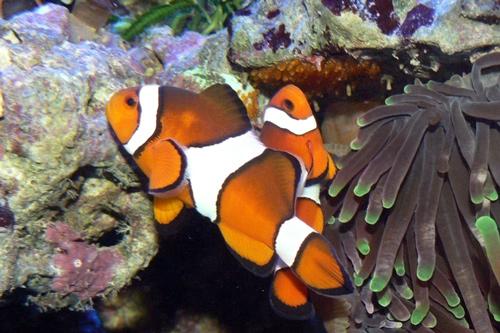Meet our clownfish (aka Nemo!)


'Amphiprion percula', commonly known as a 'Clownfish' (or Nemo!) Image courtesy of Haplochromis via Wikimedia commons.
Hi, I'm Alyster and I'm an aquarist at the Aquarium at World Museum. Over the next few months I'm going to introduce you to some of the fish in our Aquarium. I'll be picking out the characters from the film 'Finding Nemo' and telling you more about the real fish behind the animation!
I'm going to start with the characters Nemo, Marlin and Coral, who are all clownfish. It’s safe to say our clownfish are one of the most popular fish in our aquarium, and often draw the most attention. Children and adults a like will point with glee and exclaim “NEMO!” It’s no surprise given the massive success of the film and the iconic look the clownfish has.
The clownfish featured in 'Finding Nemo' are Percula clownfish or 'Amphiprion percula'. There are 30 different species of clownfish, we keep three different kinds including the percula. Percula clownfish are found in the Western pacific - Queensland and Melanesia. They’re found in coral lagoons and reefs flats, and inhabit The Great Barrier Reef. Clownfish have a mutual beneficial relationship with sea anemones.
Our clownfish live in Magnificent Sea Anemones, but they can also inhabit other types. Anemones are venomous, they use the stings on their tentacles, to paralyse and hold on to other fish for food. They don’t sting the clownfish - no solid reason has been found as to why this is - but there are a few theories. One well regarded theory is that clownfish build up an immunity to the sting. When a clownfish is introduced to a new anemone they don’t just dive straight in, they shimmy up to the anemone, letting the tentacles touch parts of their body, and shimmy away, then shimmy back up. Once at full immunity the clownfish can pop right into the anemone and stay there.
The anemones provide protection to the clownfish, as clownfish are clumsy swimmers, they don’t venture too far from their host anemone, if they were to a swift predator like a shark would snap them up right away. Anemones also provide food to the clownfish, they will pick at the fish the anemone has caught and also pick off any dying tentacles. The anemone also benefits from the presence of a clownfish. Butterfly fish are known to eat anemones, the clownfish will bump and bash into any hungry butterflies and warn them off, the clownfish faeces also supplies the anemone with sustenance.
Clownfish are protoneous hermaphrodites, this means that all clownfish are born male and the biggest will change into a female. In the wild there will be a breeding pair, male and females, and also 0-4 other smaller males in their group. If the female dies, the mating male changes sex to female and the largest of the group of males will become the breeding partner. So, when Coral died in the film, Marlin would change to Nemo’s mother!
Though the clownfish look pretty cute, they’re actually one of the most aggressive fish we keep in the aquarium. They’re very territorial and if introduced to new clownfish they will fight and won’t let them into the safe haven of the anemone. We as aquarists have to be mindful not to get out hands too close to their anemone when our hands are in the tank cleaning it. The clownfish will see our hand as a threat and attack it. You’d be surprised how much punch these little guys pack!
